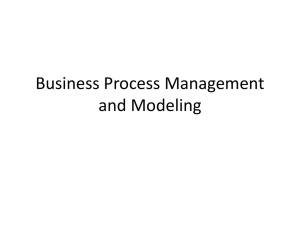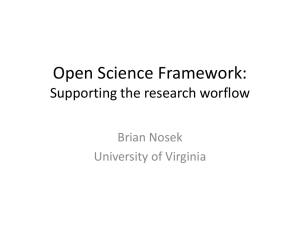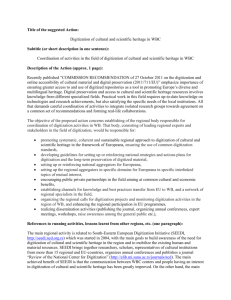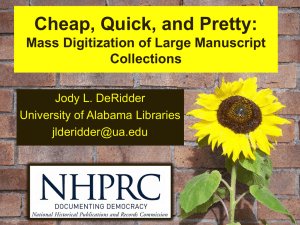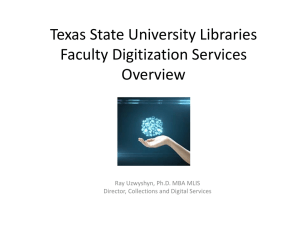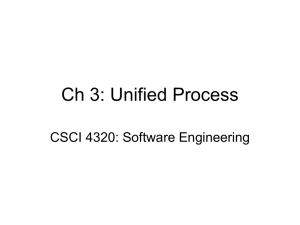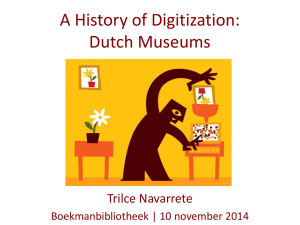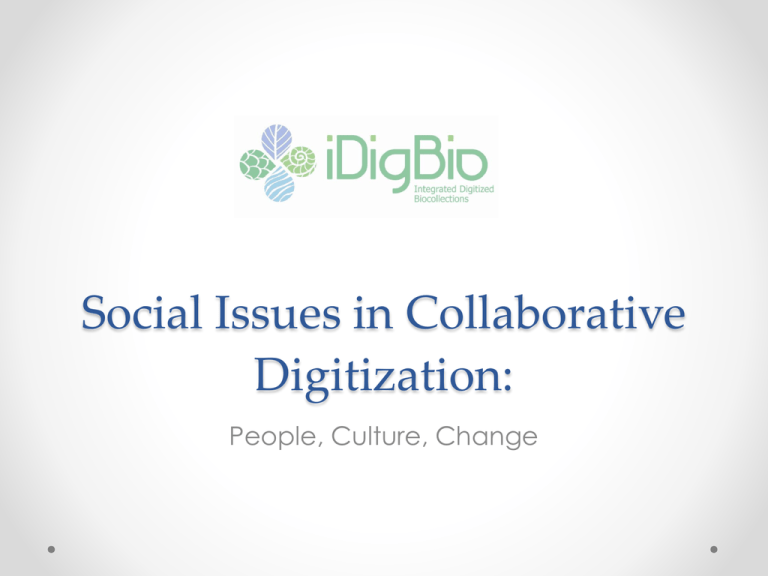
Social Issues in Collaborative
Digitization:
People, Culture, Change
Overview
observing digitization workflows
social issues
business processes
change, management & motivation
some changes seen
opportunities for redesign
o evaluating & redesigning workflows
• digitization & cultural maturity
• interesting bits seen here already
•
•
•
•
•
•
Observing Collections
Digitization
• iDigBio staff visited
o 28 Collections in 10 different museums
o Collections varied in size, kind, staffing
• entomology
• invertebrate paleontology
• invertebrate zoology
• ornithology
• botany
• vertebrate paleontology
• zoology
• Paper submitted to ZooKeys
o Not about social issues
Why discuss
~ the social issues?
• all of our hard problems are people problems
o Technology problems can be solved!
• we'd like to
o avoid re-inventing the wheel
o use the resources we do have
• in the most effective manner possible
• to benefit as many as possible
o take advantage of existing knowledge about social
issues
Social Issue Layers
specimens as boundary objects
Community
think small science to big science
Organization
the museum
the individual collection
The individual digitizing
Overview
observing digitization workflows
social issues
business processes
change, management & motivation
some changes seen
opportunities for redesign
o evaluating & redesigning workflows
• digitization & cultural maturity
• interesting bits seen here already
•
•
•
•
•
•
the three r’s
business processes applied to
workflow process improvement
• review
o observe
o document
o evaluate
• redesign
o observe
o document
o evaluate
• reengineer
layers of change
http://www.jiscinfonet.ac.uk/infokits/process-improvement
3 aspects of
change
management
process
people
•
culture
http://www.jiscinfonet.ac.uk/infokits/change-management/aspects-of-change
Change
The irrational side of change management
o Aiken & Keller, 2009 in The McKinsey Quarterly
what motivates you ≠ what motivates others
we’re better off listening, rather than telling
we need the + and the –
leaders mistakenly believe that they already “are the change”
it’s not just about the leader, it’s about how receptive
“society” is to the ideas
• money is the most expensive way to motivate people.
o satisfaction equals perception minus expectation.
o small unexpected rewards can have disproportionate
effects.
• process and outcome have to be fair to get buy-in
•
•
•
•
•
Motivation
• What is known about what motivates us?
• Where can we integrate what is known about motivation into
our workflows?
• autonomy
o if task order doesn’t matter
o collecting and integrating feedback
• are you doing this?
• if not, you are losing information
o does task method matter?
• mastery
o
o
o
o
o
o
software skills
hardware skills
people skills
training (giving and receiving)
knowledge (collections, curation, content)
use mastery where you can
• purpose
•
•
o engagement & inspiration
o the ADBC initiative is rich with purpose > capitalize on this
http://www.danpink.com/archives/2010/06/whiteboard-magic
http://youtu.be/u6XAPnuFjJc
Overview
observing digitization workflows
social issues
business processes
change, management & motivation
some changes seen
opportunities for redesign
o evaluating & redesigning workflows
• digitization & cultural maturity
• interesting bits seen here already
•
•
•
•
•
•
Workflow Evolution ~
things people changed (adaptation)
tweezers (aka forceps)
autonomy to alleviate boredom
keystroke short cuts
ocr to validate scanned barcode entry
opportunistic use of mastery / skill sets
tracking flow
o what happens when there’s a problem or question?
o where do problems go?
o losing information
o capturing feedback from staff
• Institutional level
o Coordinated effort
o Ready and willing to try a new strategy
o Avoiding the N-i-H syndrome
•
•
•
•
•
•
A Unique Tool for the Job: Forceps ~
http://www.ecnweb.org/dev/files/12_Eastwood_2010.pdf
Task Order / Task Method
• Task order didn’t matter
o imaging data entry
o update taxon names imaging
• Task method didn’t matter
o sort by collecting event
o apply barcodes
• Social effects
o autonomy
o alleviates boredom
o engages worker giving them a choice
o novel strategies (mastery and purpose)
Keystroke Shortcuts
• Keystroke more efficient than mouse
o Keystroke shortcut training
o Keystroke shortcuts posted prominently
o Keystroke vs. mouse
• Social effects
o seems to engage workers
o steps reduced (no mouse) less tedious
o novel strategies
Software Automation
• Barcode Capture and Validation
o barcode captured 2 ways
• scanner
• OCR
o software compares the 2 values, reports any mismatch
o increases data integrity
o reduces human quality control steps
• Social effect
o focuses human quality control steps less tedious
Using Skill Sets
• opportunities to use individual skills
o typing
o imaging
o language
o writing
o software / hardware
• student / staff reads Russian Russian labels
• student is meticulous updating taxonomy on specimens
to latest names
• students / staff share what works with each other
• effects
o efficient use of talent (resources)
o engaging someone’s sense of purpose and usefulness
allowing them to utilize mastery
Openness to Change
• Our Welcome.
• Upon arriving, Gil and I were greeted warmly and invited to a
group luncheon – all hands staff. There, the director encouraged
us to share any observations about processes they could
change or improve.
• Later, seeing the image processing workflow, we mentioned the
2-way barcode capture and automated barcode validation*
mentioned earlier and the staff implemented this change onthe-spot.
• Effects:
• increased data integrity
• reduced human quality control steps
• reinforced importance of observation, sharing, and
openness to change.
5 important principles of effective
workflows…
•
•
•
•
•
The Bioinformatics Manager is a key
People do the digitization
Processes and workflows vary
Workflows and protocols are business processes
Communication within and among projects is crucial
Overview
observing digitization workflows
social issues
business processes
change, management & motivation
some changes seen
opportunities for redesign
o evaluating & redesigning workflows
• digitization & cultural maturity
• interesting bits seen here already
•
•
•
•
•
•
Evaluate a Workflow
Pre Digitization must be
Curation
done
Tasks
before
digitization
could be
done at or
after
digitization
Non
expert
Crowd a step that a task
Source? could be
needing
automated QC / QA
Can do
with
existing
machine
(Kirtas)
Authority a physical
file exists tool exists
or would
be useful
• Workflow (WF)
o Documentation of WFs
interview staff
o Improving WFs
hire staff
train staff
•
Talking
with
others / comparing
decide what to
digitize
WFs
pull specimenso Evaluating
sort specimens
• See WF Mockups – for DROID workshop
(e.g., by taxon,
sex, geographic
region,
collecting
event,
collector)
add taxon
names to
database
update
taxonomic
identification
on specimens
(e.g., vet type
specimens)
easy to
formula
compute exists
time /
costs for
this task
Why Slow Steps Occur
• Lack of
o sound process design
o resources (use what we have wisely)
o process knowledge automation
o automation
• Poor scheduling and allocation of resources
• How to find the slowest step/s?
o “ask the people who work within the process”
• http://workflow.wordpress.com/2006/10/11/workflo
w-strategies-for-getting-around-chokepoints/
Tweak the Slowest Step/s
1. if possible: divide task into sub-tasks
• see if those tasks can be parallel
2. if not, can resources be allocated to the new tasks?
3. can the slow task be placed in parallel with other
tasks?
4. can more resources be allocated to the slow step?
5. can any part of the slow step be automated?
6. if it’s taking too long, can you reassign it? can you
send an alert?
7. will scheduling it differently help?
http://workflow.wordpress.com/category/efficiency/
Organization
Maturity
Six maturity levels for core digitization activities [Kalms 2012]
Your Workflows
Some highlights noted before the workshop
o Software review: Photoshop batch limitations
o Andrew Bentley: space (field, lab)
o Paul Morris: workflow steps
+ skill levels (using color)
+ human or software mediated steps (using color)
+ timing (overlay)
+ data quality / data integrity tracking
o Louis Zachos:
• specimen handling (where it starts / stops)
• legacy database
• georeferencing (Dorothy, Ed, Paul H. Andy)
o Linda Ford: the organizational process model
• collaborative connections for output
• collaborative database development
o Melissa Tulig, Michael Bevans, Louis Zachos: throughput
o Ed Gilbert: automated OCR/NLP/Georeferencing & parsed fields
o Dorothy Allard: explicit qc / qa and implicit qc
Keep in Mind
•
•
•
•
•
Communication, Culture & Community Awareness
o Visit to see what others are doing
o Contribute to the process, (example): learning how to document and
evaluate workflows to find our common core processes and move forward.
Comfort
o Work outside your comfort zone (Judy Skog)
o Ask for feedback
Work collaboratively ~ Share
o social events
o workshops and training events (here!)
o contribute to FAQ or Q and A
o wikis
Influence others, be
o open
o clear
o transparent
Keep Enterprise 2.0 in mind…
o “Let people do the work – they’ll create amazing stuff.”
Life in Perpetual Beta
http://www.jarche.com
• “You have to have an idea of what you are going
to do, but it should be a vague idea.”
o Pablo Picasso
• Ignorance more frequently begets confidence than
does knowledge.
o Darwin (The Descent of Man, Volume 1 page 3)
Social Issues in Collaborative Digitization…
•
•
•
•
•
•
•
•
•
•
Barton, J. 2005. “Digital libraries, virtual museums: same difference?”, Library Review, Vol. 54
No. 3, pp. 149-54
Reed Beaman, James Macklin, Michael Donoghue, James Hanken. 2007. Overcoming the
Digitization Bottleneck in Natural History Collections: A summary report on a workshop held
7 – 9 September 2006 at Harvard University. [Accessed January 2012]
ĺñigo Granzow-de la Cerda and James H. Beach. December 2010. Semi-automated
workflows for acquiring specimen data from label images in herbarium collections. Taxon
59 (6): 1830-1842
Bryan Kalms. 2012. Digitisation: A strategic approach for natural history collections.
Canberra, Australia, CSIRO
Liew, Chern Li. 2009. Digital library research1997-2007:Organisational and people issues.
Journal of Documentation 65(2): 245 – 266 http://dx.doi.org/10.1108/00220410910937606
Eric T. Meyer. 2009. Moving from small science to big science: Social and organizational
impediments to large scale data sharing. In: E-Research: Transformation in Scholarly
Practice. Jankowski, Nicholas W. (Ed), Routledge. 350 pp.
Susan Leigh Star and James R. Griesemer. 1989. Institutional Ecology, ‘Translations’ and
Boundary Objects: Amateurs and Professionals in Berkeley’s Museum of Vertebrate
Zoology, 1907 – 1939. Social Studies of Science 19: 387 – 420
John Tann & Paul Flemons. 2008. Report: Data capture of specimen labels using volunteers.
Australian Museum
Ana Vollmar, James Alexander Macklin, Linda Ford. 2010. Natural History Specimen
Digitization: Challenges and Concerns. Biodiversity Informatics 7 (1): 93 – 112
iDigBio Workshop: Developing Robust Object to Image to Data Workflows May 30 – 31, 2012
Acknowledgment & Thanks
American Museum of Natural History (AMNH)
Botanical Research Institute of Texas (BRIT)
Florida Museum of Natural History (FLMNH)
Florida State University (FSU)
Harvard Herbarium (HUH)
Museum of Comparative Zoology (Harvard)
New York Botanical Garden (NYBG)
Southeast Regional Network of Expertise and Collections (SERNEC)
Specify Software Project (University of Kansas)
Symbiota Software Project (Arizona State University)
Tall Timbers Research Station and Land Conservancy (TTRS)
Tulane University Museum of Natural History
University of Kansas Biodiversity Institute Entomology Department
Valdosta State University (VSU)
Yale Peabody Museum (YPM)
and all participants at the iDigBio DROID Workflows Workshop
May 30 – 31, 2012 University of Florida


